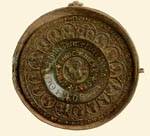|
|
| Byzantine Minor Arts |
12th-13th c. Chelandari Monastery Jasper (?) and silver, with enamelwork Diameter 8.1 cm; 9.6 cm with sheathing |
|

|
This panagiarion-enkolpion is a broad-rimmed disc which has been set into a spherical, hinged case with a lid much more recent than the panagiarion itself; two attached rings enable it to be worn as an enkolpion. Both sides of the case are decorated in cloisonnι enamel technique, known as modo transylvano or modo ragusano, which became popular in about the middle of the seventeenth century (Byzantine and Post-Byzantine Art 1986, no. 223); the decoration here is a scroll of flower motifs, framing a Greek cross. At the centre of the panagiarion is a round medallion, forming the bottom of a shallow dish with a broad, flat rim. Carved in low relief on the medallion is a half-length depiction of the Virgin, frontal, arms outstretched in supplication. This representation displays certain similarities with busts of the Virgin on cameos like the one in the Monastery of Chelandari. The halo and the monogram Μ(ητ)ΗΡ Θ(εο)Υ are incised. The medallion is encircled by an abbreviated (?) inscription incised in majuscules, reading: '+ΜΓΧΒ + ΡΚΑΤ + ΔΠΜC + ΕΩΘC'. Traces of red are still visible in the incised letters. Moving outward, the smooth, slightly convex rise bears another inscription, also incised in larger capitals: '+ ΠΑΝΑΓΙΑ + Θ(εοτό)ΚΕ ΒΟ + ΗΘΕΙ Η + ΜΙΝ ΤΚΠΓ' (Most Holy Mother of God help us). The flat rim is decorated in low relief with sixteen arches framing fourteen busts of saints, probably apostles and prophets, and the scenes of the Crucifixion and the Anastasis. A third incised inscription runs around the outer edge of the rim: '+ ΚΑΘΑΡCΗΟΝ CΩΜΑΤΟΣ ΚΑΙ ΨΥΧΗC ΡΗΠΩΝ + ΩC ΛΑΒΑ ΦΡΙΚΤΗΝ ΠΑΡΘΕΝΕ + ΦΕΡΟΥCΑΝ ΑΡΤΟΝ ΑΝΘΡΑΚΟΔΙ ΠΥΟΦΟΡΟΝ +' (O Blessed Virgin, bearer of the Bread that like a fierce lava cleanseth body and soul ....). The inscription on the central medallion has symbolic (?) abbreviations. The second, on the shallow sides of the vessel, is a supplication to the Virgin, probably on behalf of the owner of the panagiarion, who however has not yet been identified; while the third, on the rim, refers to the function of the vessel, that is, to hold the holy bread during rituals in honour of the Virgin. Iconographically, the decorative motifs - especially the two scenes - appear to associate the Virgin and the Holy Eucharist. In the arrangement of the figures (busts under arches) there is a resemblance to the fourteenth-century steatite panagiaria from the Monastery of Xeropotamou (no. 9.5) and Panteleimon (Kalavrezou-Maxeiner 1985, pp. 204-8, pls. 64-5). The closest parallel, however, in both style and iconography, is the twelfth-century Ravenna panagiarion (Radojcic 1955 (1), p. 184, with bibliography), and it is on this basis that an earlier dating has been preferred.
| |
|
Bibliography: Radojcic 1955 (1), pp. 184-5, fig. 45.
| ||
| K. L-T. | ||
| Index of exhibits of Monastery of Chelandari 12th century |
||
Reference address : https://www.elpenor.org/athos/en/e218ci9.asp